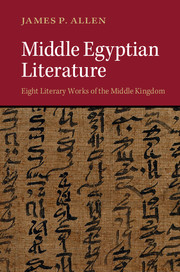Book contents
- Frontmatter
- Contents
- Introduction
- Text 1 The Story of the Shipwrecked Sailor
- Text 2 The Story of Sinuhe
- Text 3 The Loyalist Instruction
- Text 4 The Instructions of Kagemni's Father and Ptahhotep
- Text 5 The Discourses of the Eloquent Peasant
- Text 6 The Debate between a Man and His Soul
- Text 7 The Herdsman's Tale
- Text 8 Hymns to Senwosret III
- Consecutive Translations
Text 1 - The Story of the Shipwrecked Sailor
Published online by Cambridge University Press: 05 January 2015
- Frontmatter
- Contents
- Introduction
- Text 1 The Story of the Shipwrecked Sailor
- Text 2 The Story of Sinuhe
- Text 3 The Loyalist Instruction
- Text 4 The Instructions of Kagemni's Father and Ptahhotep
- Text 5 The Discourses of the Eloquent Peasant
- Text 6 The Debate between a Man and His Soul
- Text 7 The Herdsman's Tale
- Text 8 Hymns to Senwosret III
- Consecutive Translations
Summary
This text is the oldest surviving ancient Egyptian story. It is preserved in a single manuscript, a papyrus now in the Hermitage Museum, St. Petersburg, Russia (pHermitage 1115). The text is written in hieratic, the handwritten form of hieroglyphic (§ 1.9), mostly in vertical columns but at one point in horizontal lines. With some exceptions, red ink is used to mark the beginning of a new section in the narration. The grammar of the text and the paleography of the hieratic date the composition to the early Middle Kingdom (ca. 2000–1900 BC).
The story is unusual in several respects: its rather abrupt beginning, its anonymous characters, its literary device of a story within a story within a story, and its downbeat ending. The moral of the tale is perseverance through travails. At the beginning of the story, an expedition up the Nile to Africa has returned apparently without success. The expedition leader has to report to the king, and to encourage him, one of the crew members tells the leader how he survived a worse situation, being shipwrecked alone on a previous mission. In the course of his story, the sailor meets a god in the form of a giant snake, who encourages the sailor by telling him how he persevered through an even worse disaster, the loss of his entire family.
Like all early Middle Kingdom literature, the Story of the Shipwrecked Sailor is composed in narrative verse (Foster 1988). Besides the basic unit of the couplet, this text also makes liberal use of tercets, the occasional single line, and one possible sestet (group of six lines). Like all literary compositions, it also uses devices such as metaphor and alliteration.
The original papyrus has yet to be properly published. The text here is transcribed, and the hieratic signs used in the notes are drawn, after Golenischev 1913; the use of red ink is from Golenischev 1912.
- Type
- Chapter
- Information
- Middle Egyptian LiteratureEight Literary Works of the Middle Kingdom, pp. 9 - 54Publisher: Cambridge University PressPrint publication year: 2014



